This post may contain affiliate links. Please read our disclosure policy.
How to make spinach noodles (aka green pasta dough) at home with just three ingredients. This homemade spinach pasta is egg-free, dairy-free, packed with nutrients, and can be used for tons of pasta shapes: egg yolk ravioli, noodles, mixed veggie lasagna sheets, etc.
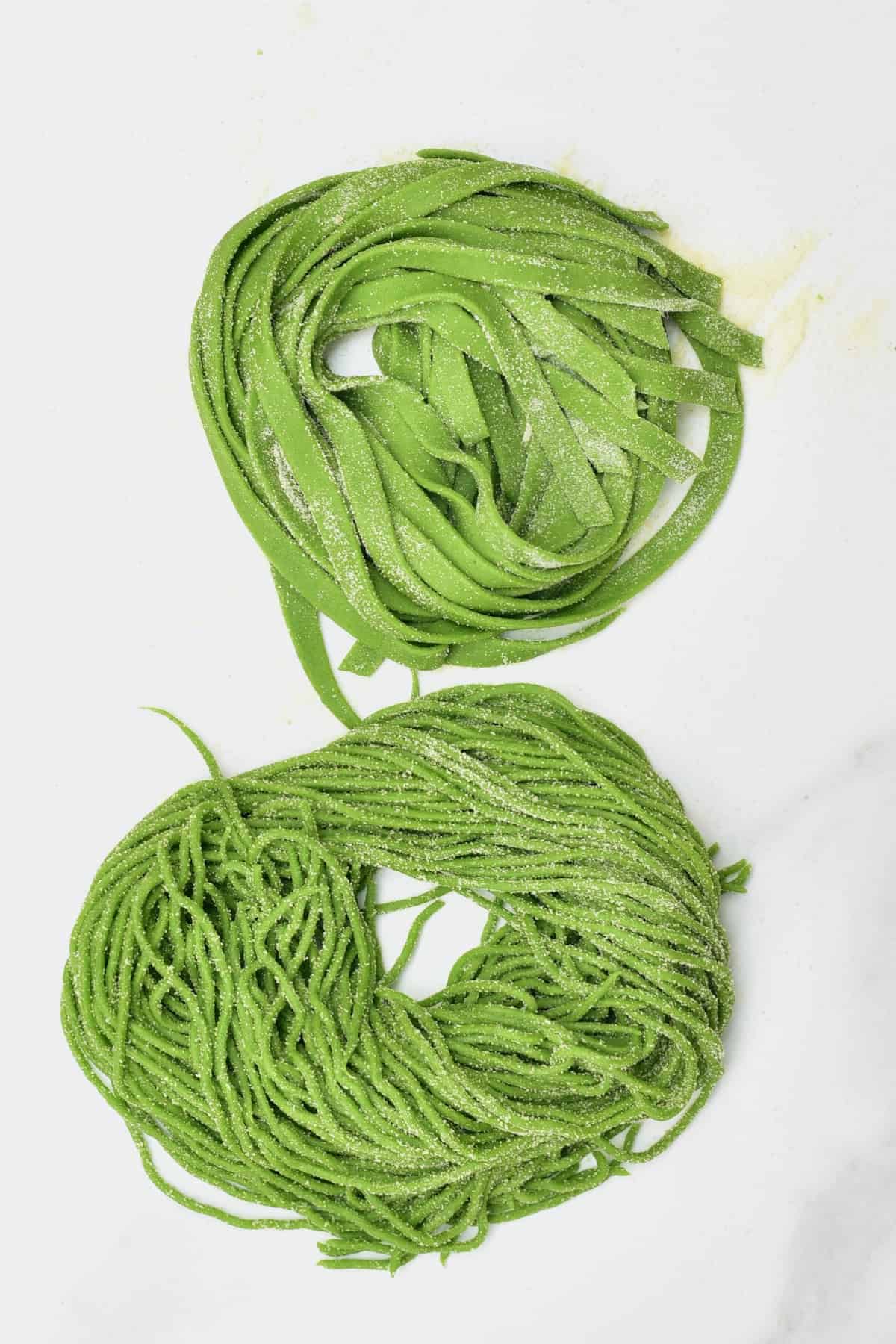
I’ve already shared recipes for homemade pasta, vegan pasta, and several gluten-free varieties, including oat and chickpea flour pasta. Now it’s the turn of these homemade spinach noodles (aka green pasta).
I already have a recipe for a Greek pasta salad using spinach and egg pasta. This time, however, I’m ditching the eggs for a 100% vegan pasta option.
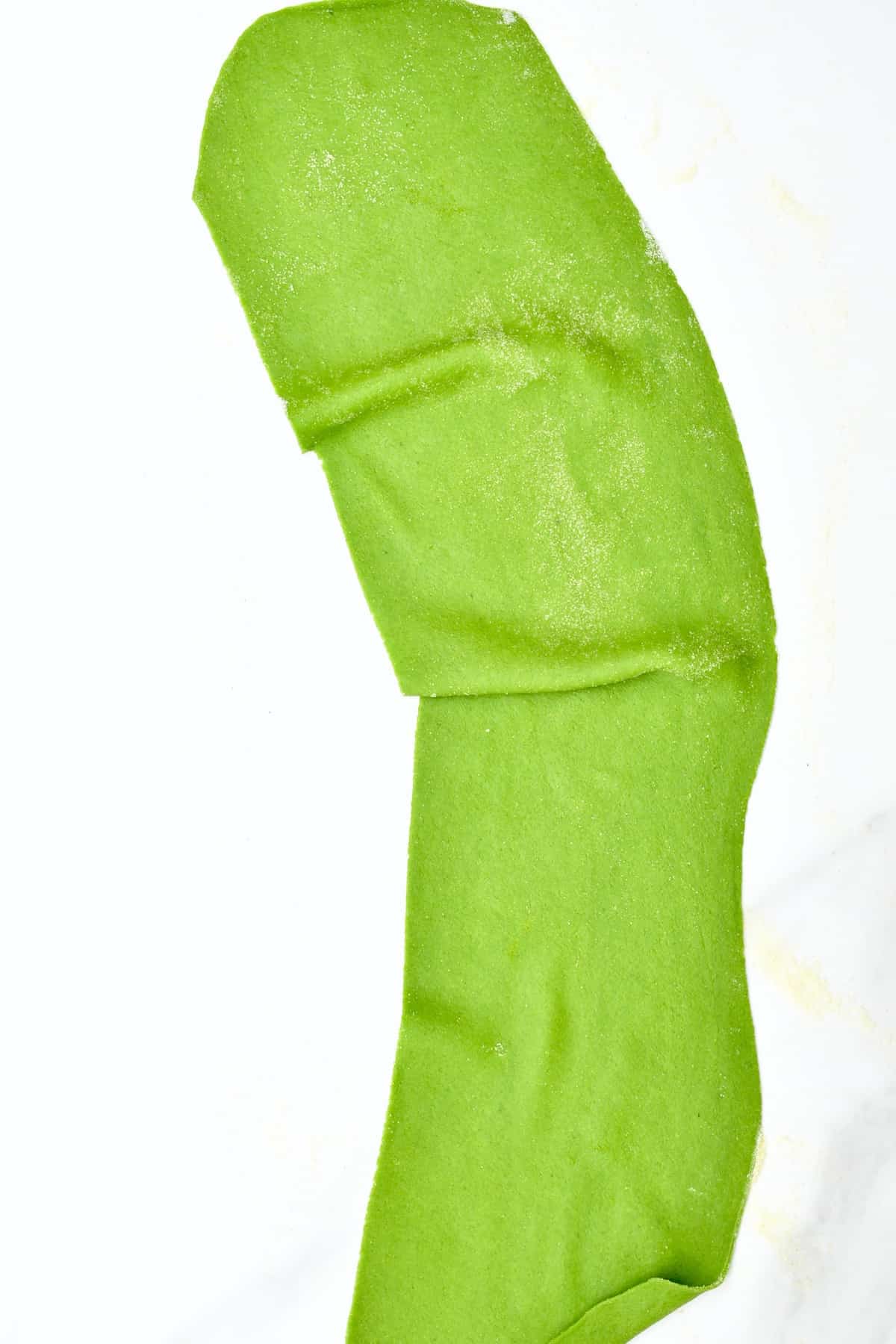
Not only are these green pasta noodles a fun color, but they add extra vitamins and minerals to your pasta with only a hint of flavor – so even spinach-hating kids will love them once they’re plated up with sauce! In fact, you can color pasta in all kinds of rainbow colors, naturally! Check out my homemade colored pasta.
Best of all, though, this recipe is completely vegan, using just three ingredients for a simple homemade spinach pasta!
Want to save this recipe?
The Ingredients
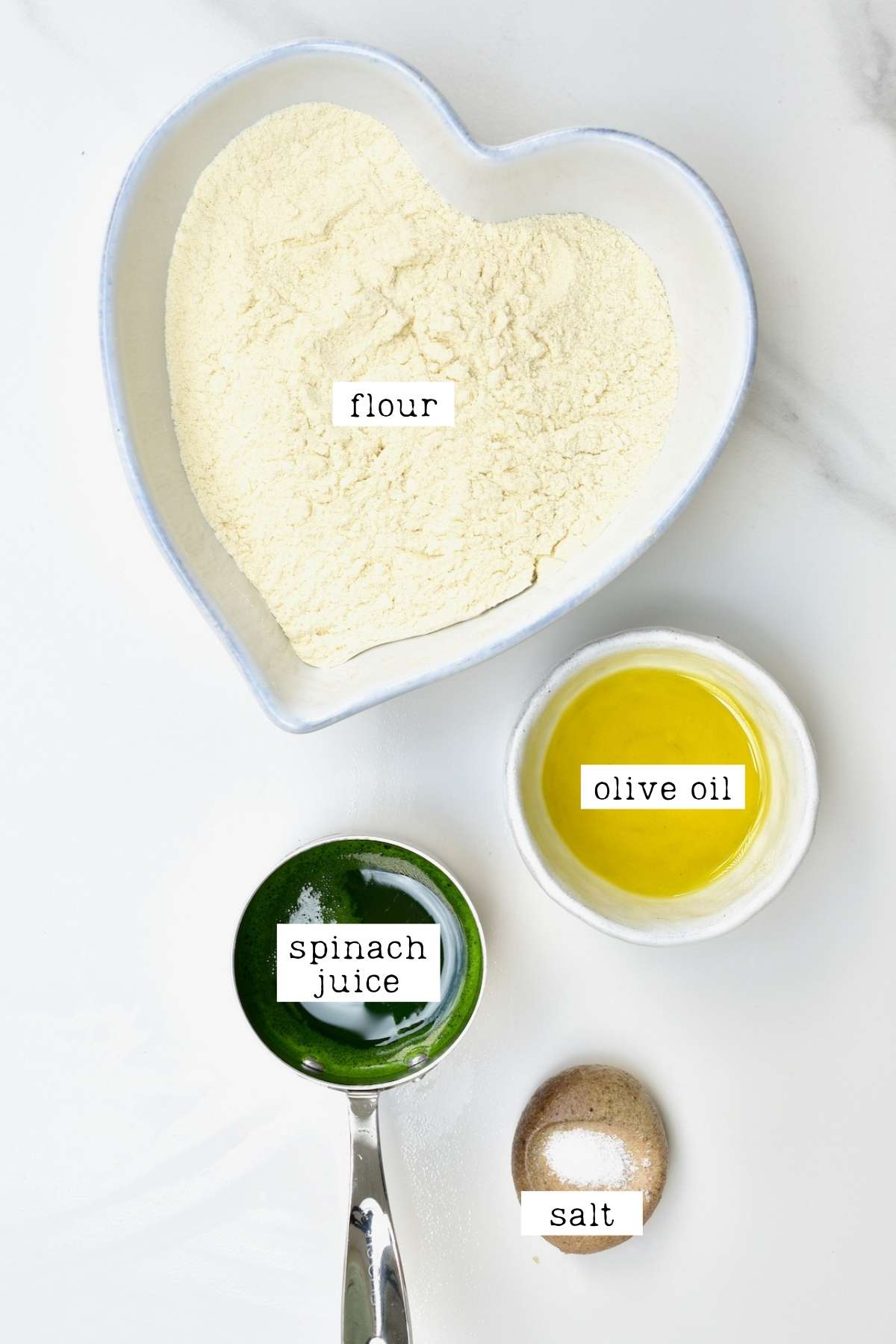
- Flour: I use 00 flour for this homemade spinach noodles recipe. You could use a combination of 00 flour and durum/semolina flour – for a slightly ‘stronger’ dough. You could also use All-purpose flour, but it will be slightly chewier and not quite as tender.
- Spinach: there are two ways to make spinach noodles. One relies on using the whole spinach (like I did for this greek pasta salad), and this recipe relies on the spinach juice only (made using a juicer) for a smoother dough.
- Olive Oil: olive oil is used to help make a more tender, supple dough that’s easier to roll out and shape.
- (Optional) Seasonings: you could also add a pinch of salt or even further seasonings like garlic and herbs or Italian seasoning to the dough for more flavor. That’s part of the fun of homemade pasta!
How to Make Spinach Noodles
Step 1: Prepare the spinach
There are two ways to prepare the spinach when making these spinach noodles (check recipe notes for the second method).
I rinse the spinach leaves and then feed them into my juicer to obtain the spinach juice.
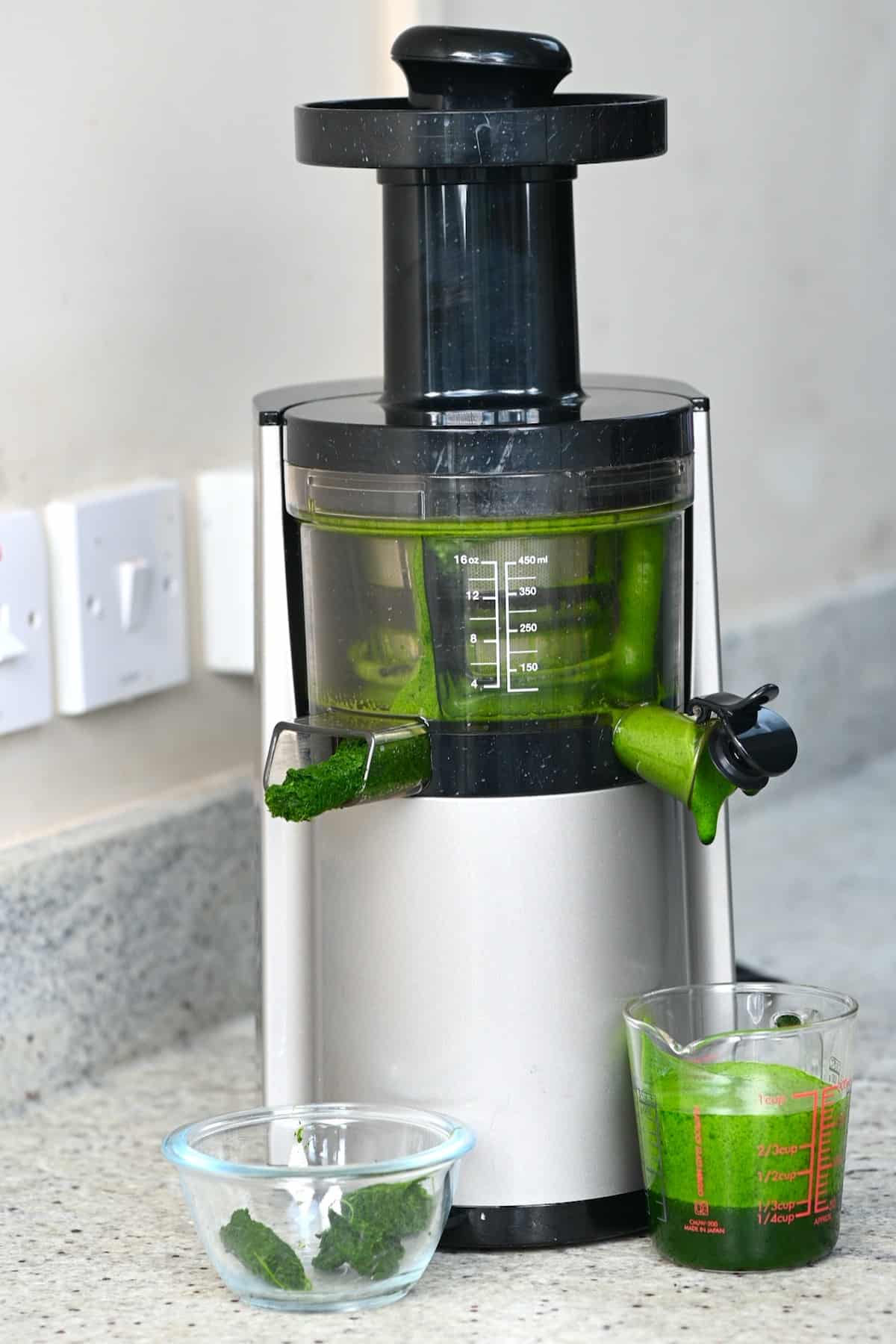
If you don’t have a juicer, you may be able to add a little water and the spinach to a blender and blend into a smooth puree/juice, and then pour it through a nut milk bag or cheesecloth to squeeze out all the juice. This isn’t a method I’ve tried, though, so I can’t guarantee results – it’s a method that works for various other juice recipes, though.
The leftover pulp can be collected and spread on a tray (or in a dehydrator) to dry out and be ground into green spinach powder.
Step 2: Prepare the green pasta dough
Add your flour in a mound onto a clean working surface and then create a well in the center and add the spinach and oil to it.
Using a fork, whisk from the center, slowly incorporating the flour into the spinach mixture to create a rough (‘shaggy’) dough, and then knead it with your hands until it is smooth and elastic.
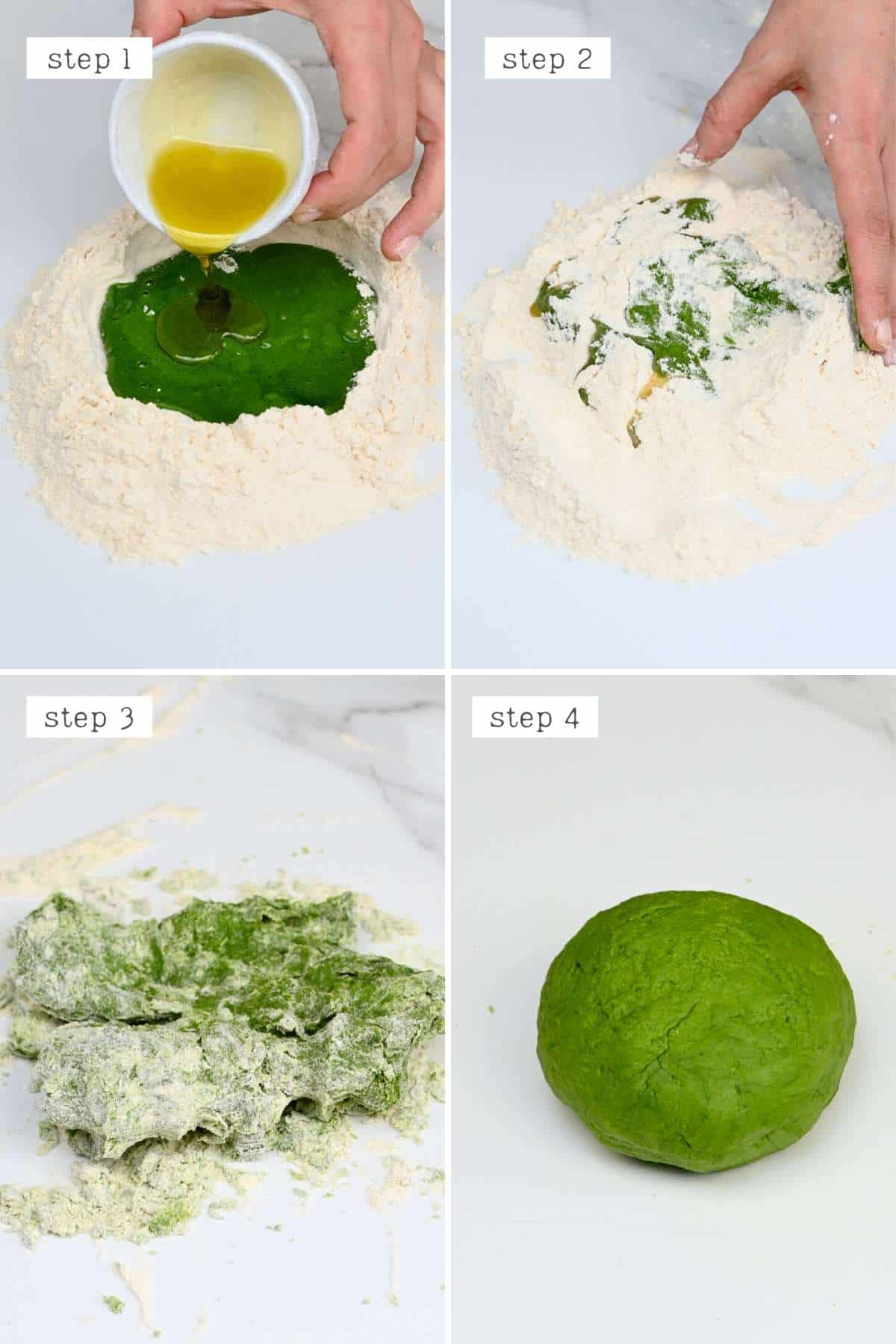
Alternatively, you can do this process with a stand mixer or food processor (with dough blade) – adding the ingredients and mixing until you obtain a smooth green pasta dough.
If the dough is too wet and sticks to your hand, add a little more flour and knead until smooth. If it’s too dry, add a little more liquid (start with just a teaspoon or two). But be patient because the dough can look a little dry, to begin with, as it takes a while to absorb the moisture from the spinach juice – keep kneading, and only right at the end of this step decide if you need a little extra flour/liquid.
Step 3: Rest the dough
Allow the dough to rest for 20 minutes, wrapped tightly in plastic wrap. This will let the gluten in the flour relax and develop. This is so that when you roll out and shape the dough, it doesn’t try to spring back into shape. Once rested, it should be tender and easy to roll out/work with.
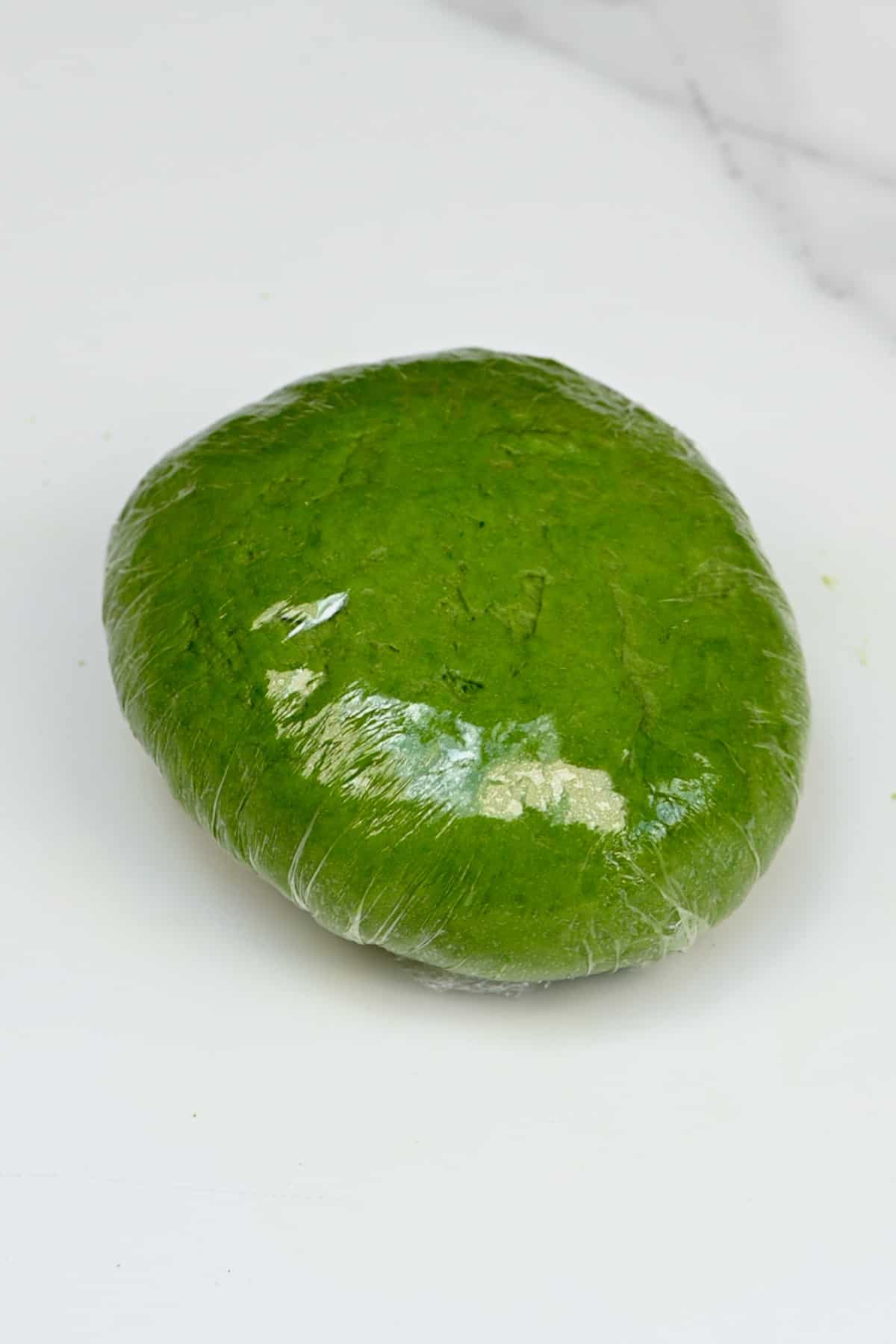
At the same time, while it rests, gather any ingredients/items you’ll need for shaping the dough – a rolling pin, extra flour/semolina flour, a knife or bench scraper, and a clean kitchen towel. If you have a pasta machine, then get that out now too.
Step 4: Roll out and shape the spinach noodles
Once rested, divide the green pasta dough into smaller, more manageable pieces (4-6 pieces). It’s now time to roll out and shape the spinach noodles.
If you’re using a pasta extruder, then there is no need to roll out the dough first. Just add as much dough as possible and press to extrude the pasta shapes.
Alternatively, you can use a pasta machine or roll out the dough by hand (if you have no pasta machine).
To hand-roll
Working with one section at a time (keeping the other wrapped tightly), use a rolling pin to roll out the dough to between 2-3mm, dusting the surface and top of the pasta with additional flour.
Once rolled out, you can use the pasta sheet for several types of pasta shapes, including mixed veggie lasagna sheets, egg yolk ravioli, and to make spinach noodles (ribbon, pappardelle, fettuccine, etc.)
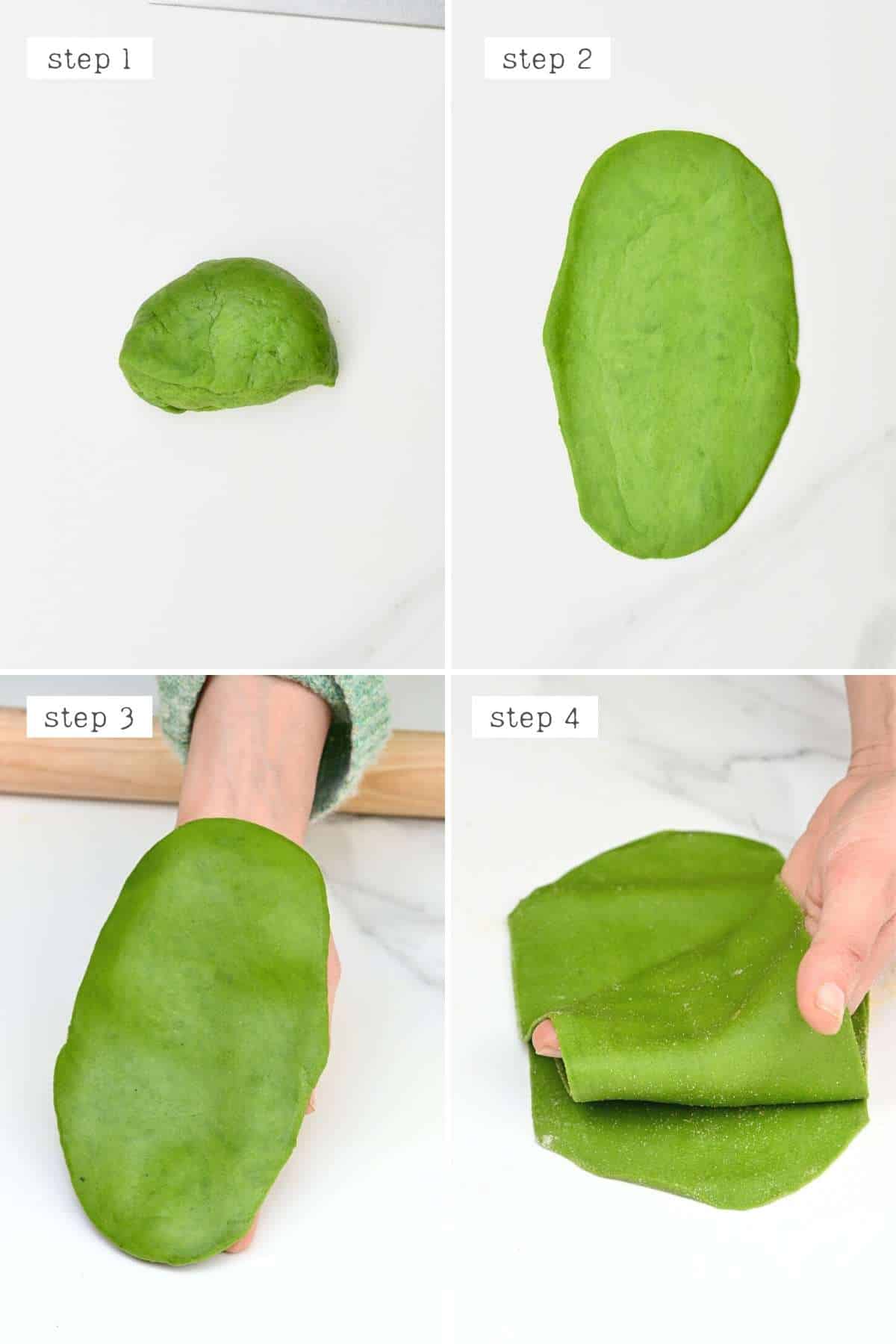
To cut the spinach noodles: liberally sprinkle the top of the pasta dough with additional flour and then loosely roll it up, trim the ends of the roll and then chop your noodles as thin/wide as you’d like them to be. Toss the noodles with more flour, and voila!
To further perfect this step. Only roll out the dough to the length that you want the noodles to be and trim the edges, so it’s a neat rectangle before rolling it up.
Repeat this will the remaining dough until it’s all ready. You should keep any prepared pasta under a clean kitchen towel to stop it drying out – unless you plan on drying the pasta, that is.
With pasta machine
Working with one section of dough at a time, roughly flatten it enough to fit the widest setting of your pasta machine.
Feed it through the machine, then fold the dough like a letter (both sides into the middle, overlapping) and re-feed the dough through the widest setting another three times.
Then work your way through the pasta settings, feeding it through once every time until you reach your desired pasta dough thickness.
You can then hand-cut the pasta shapes or use the pasta machine’s separate attachments for various spinach noodles (spaghetti and wider noodles, usually). Repeat this with the remaining dough. You can then cook any pasta immediately or dry/store it for later.
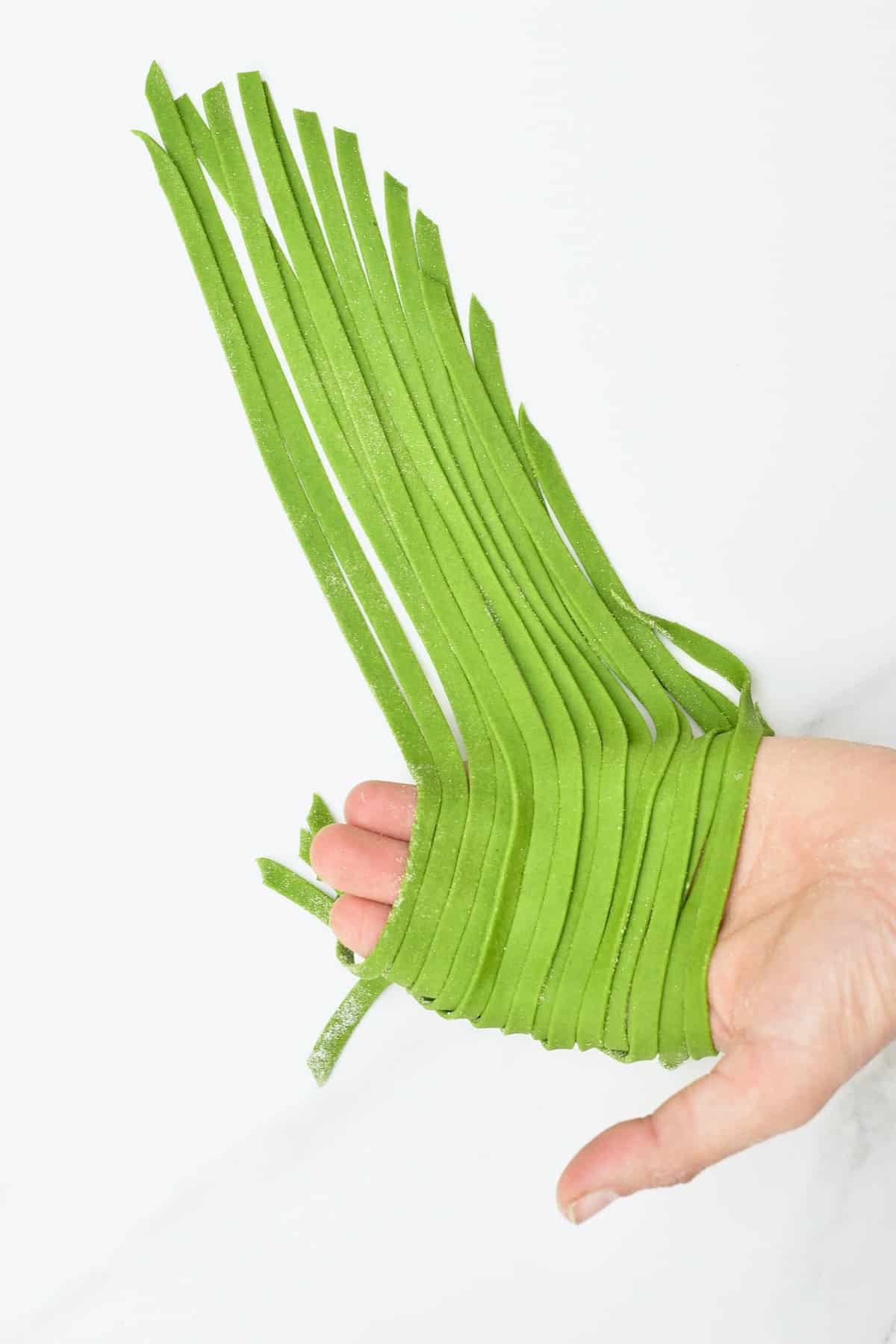
To dry the pasta, you can use a hanging apparatus or form the noodles into nests and allow them to dry out at room temperature or within a dehydrator until they ‘snap’ rather than bend.
How to Store the Spinach pasta?
Fridge: Aim to use fresh pasta dough within 1-2 days. Meanwhile, store it in an airtight container in the fridge until it’s ready to use, sprinkled with lots of flour to avoid sticking.
Freeze: I like to freeze these spinach noodles in ‘nests.’ form nests with one portion of the pasta and sprinkle with extra flour. Lay the nests on a tray and freeze until solid, then store in an airtight container for between 2-3 months. If you dry the pasta first, then you can store it for 6 months.
Dried: Once the pasta is dried, you can store it at room temperature for several months.
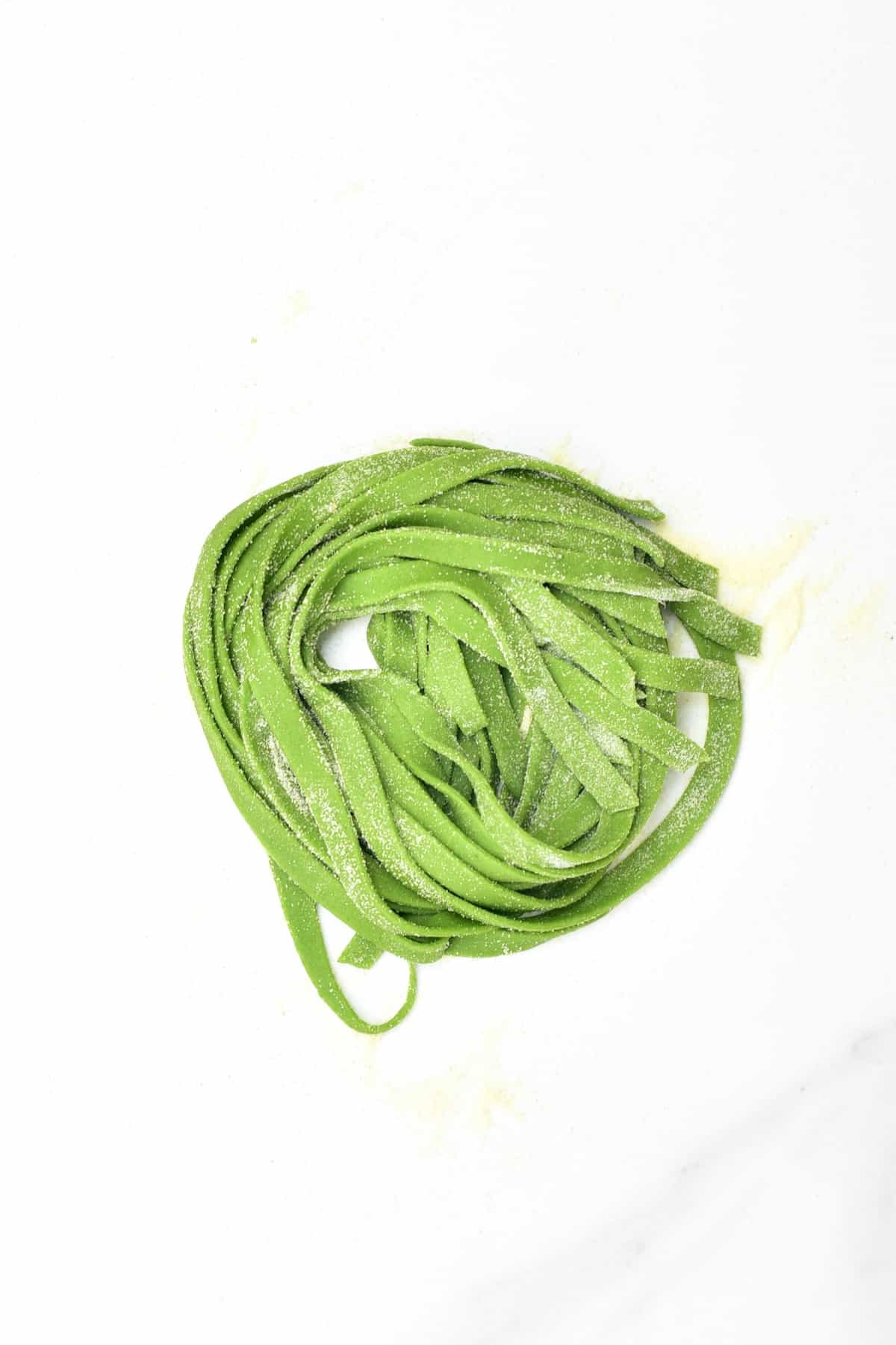
How to Cook the Spinach Noodles
- Bring a large pot of salted water to a boil and add the spinach noodles, stirring to stop them from sticking.
- Cook the spinach noodles until al dente. This should only take 1:30-3:00 minutes (usually 1-2 minutes longer if using frozen spinach pasta and 2-4 minutes longer if using the dried pasta).
- Once ready, drain and serve with the sauce of your choice!
This can take a different amount of time depending on the thickness and shape of the pasta.
How to Serve Homemade Spinach Pasta
Enjoy these spinach noodles the same way you would other pasta! Here are a few sauce/serving suggestions:
- Delicious Vegan Basil Pesto (with pistachios)
- Turn it into Raviolo al uovo
- Creamy Avocado Pasta Sauce (Green Pasta) for ‘la pasta Verde.’
- Homemade Roasted Tomato Sauce (Homemade Pasta Sauce)
- Super Creamy Vegan Mushroom Sauce Pasta
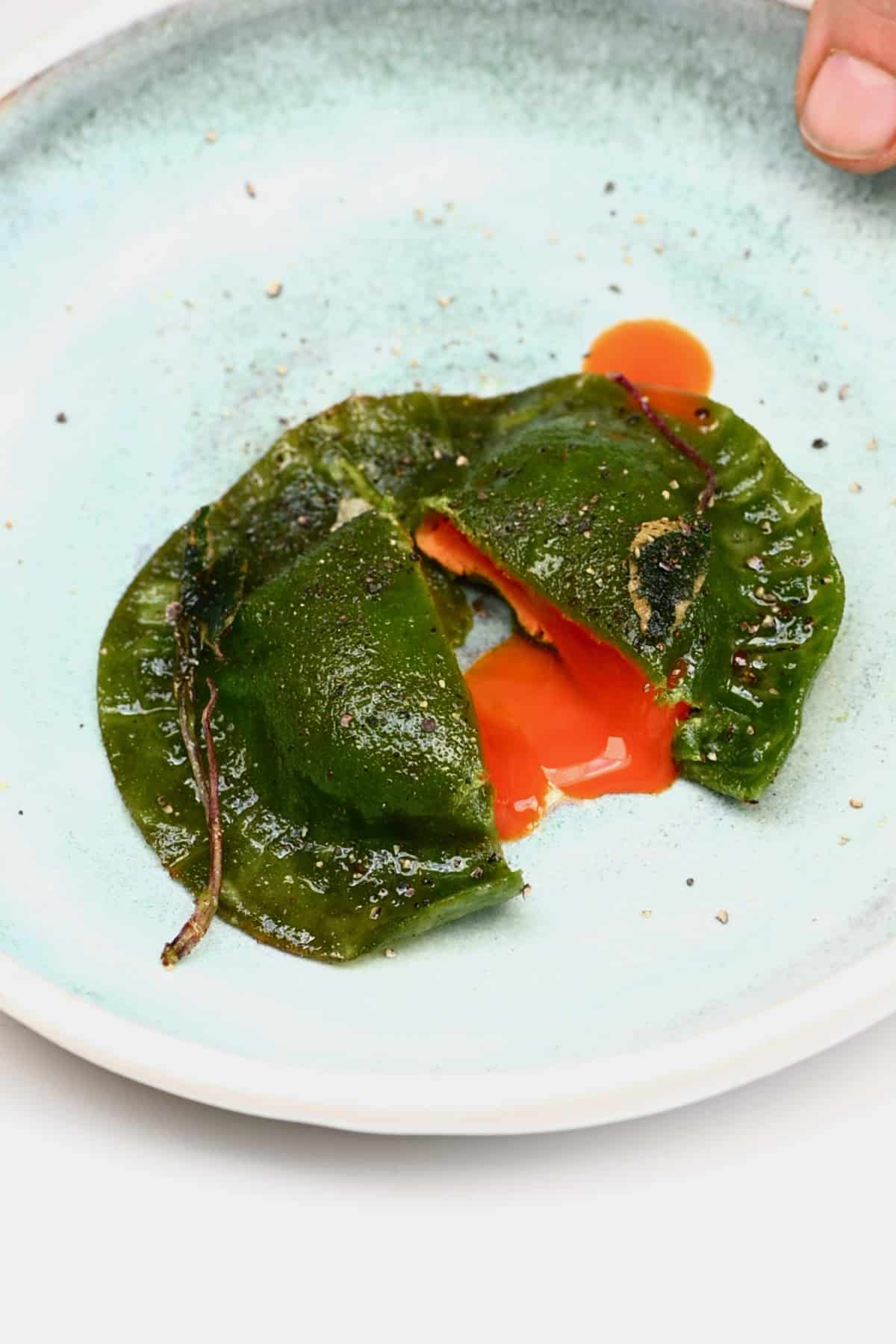
FAQs
When making homemade pasta, the general rule is that 100g flour plus 1 egg is one pasta portion. This recipe is egg-free but similar in that it will be about 100g of flour per portion.
I recommend adjusting the recipe amount based on how many portions you want; then – when you divide the dough to roll it out – cut as many pieces as there are portions (optionally weighing the dough for exact portions) to know exactly how much there is per portion.
There are technically several ways to introduce spinach to pasta dough. I’ve used a steaming, draining, and chopping method for this Greek pasta salad. However, since this recipe relies on the spinach liquid, I’d recommend steaming the spinach then adding it to a high-speed blender to process into a puree.
This will make a higher volume of spinach mixture compared to using the juice, so I would add 2/3 of it to the flour to begin with, and then increase 1 Tbsp at a time as needed.
I haven’t tried, but yes, swapping out the spinach for kale, for example, should work fine – the color and flavor will obviously vary, and you may need different amounts of the greens to yield the same amount of juice/puree.
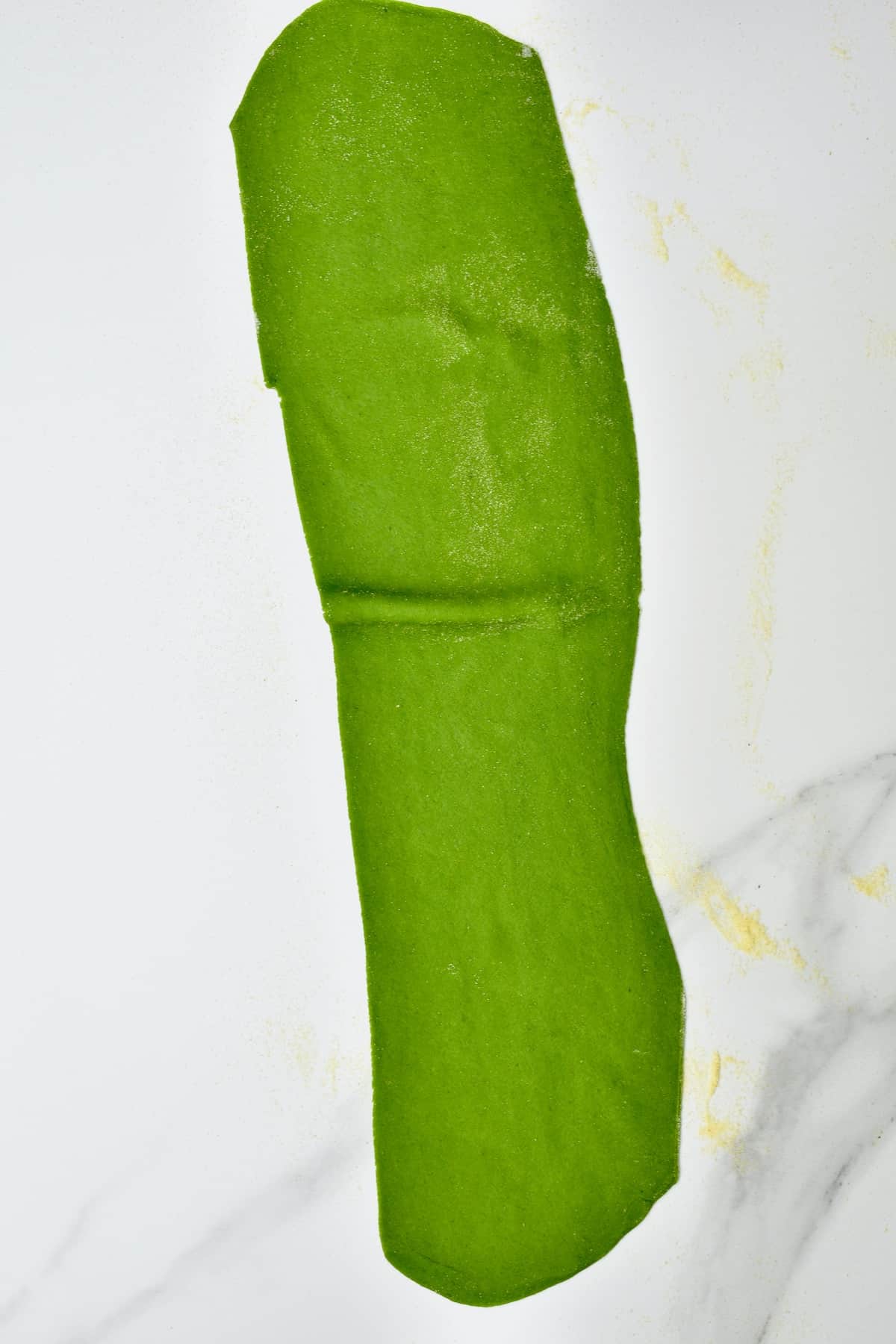
Recipe Notes & Variations
- Add herbs: to infuse the pasta with even more flavor, you can juice/puree herbs along with the spinach such as basil or cilantro, etc.
- Make sure to flour often: flour your surface, the rolling pin, pasta machine, and both sides of the pasta dough often to avoid any sticking.
- For more advice: And FAQ answers, you can check out my posts for homemade pasta and homemade vegan pasta.
- Roll the pasta out thin: When hand-rolling the pasta, it can be tricky to get it as thin as needed. The aim is for somewhere between 1-3 mm, 2 mm is great if possible.
- The flour liquid ratio will vary: Based on all sorts of factors, including your specific flour, the temperature, climate, etc., so the amount of liquid vs. flour can change from batch to batch and be different than mine. It can take some time, but you’ll get used to feeling when your dough is ready vs. when it needs more liquid/flour within a couple of batches. Just make sure to be patient and add just a bit of extra flour or liquid at a time.
Other Homemade Pasta Recipes
- Fresh Home-made Spinach Green Pasta (egg pasta)
- Homemade Spinach Raviolo al uovo (egg yolk ravioli)
- Easy Homemade Potato Gnocchi
- How to Make Chickpea Flour Pasta
- Homemade Vegan Pasta
- All-Natural Homemade Rainbow Pasta
- Homemade Ricotta and Spinach Ravioli
- How to Make Oat pasta (3 Ingredient Gluten-free Pasta)
- How to Make Beet Pasta (Pink Pasta Recipe)
If you try this homemade spinach noodles recipe, I’d love to hear your thoughts/questions below. Also, I’d really appreciate a recipe card rating below, and feel free to tag me in your recipe recreations on Instagram @Alphafoodie!
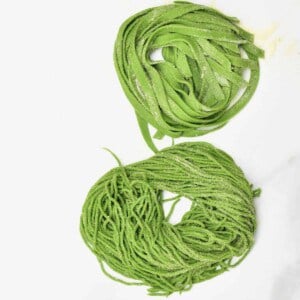
How to Make Spinach Noodles (Green Pasta Dough)
Equipment
Ingredients
- 7 oz 00 flour or all-purpose
- 1/2 cup spinach juice
- 2 Tbsp olive oil
- 1/4 tsp salt
Instructions
Step 1: Prepare the spinach
- There are two ways to prepare the spinach when making these spinach noodles (check recipe notes for the second method).
- I rinse the spinach leaves then feed them into my juicer to obtain the spinach juice.If you don’t have a juicer, you may be able to add a little water and the spinach to a blender and blend into a smooth puree/juice, and then pour it through a nut milk bag or cheesecloth to squeeze out all the juice. This isn’t a method I’ve tried, though, so I can’t guarantee results – it’s a method that works for various other juice recipes, though.The leftover pulp can be collected and spread on a tray (ow within a dehydrator) to dry out and be ground into green spinach powder.
Step 2: Prepare the green pasta dough
- Add your flour in a mound onto a clean working surface and then create a well in the center and add the spinach and oil to it.
- Using a fork, whisk from the center, slowly incorporating the flour into the spinach oil mixture to create a rough (‘shaggy’) dough, and then knead it with your hands until it is smooth and elastic.Alternatively, you can do this process with a stand mixer or food processor (with dough blade) – adding the ingredients and mixing until you obtain a smooth green pasta dough.
- If the dough is too wet and sticks to your hand, add a little more flour and knead until smooth. If it’s too dry, add a little more liquid. But be patient because the dough can look a little dry, to begin with as it takes a while to absorb the moisture from the spinach juice – keep kneading and only right at the end of this step decide if you need a little extra flour/liquid.
Step 3: Rest the dough
- Allow the dough to rest for 20 minutes, wrapped tightly in plastic wrap. This will let the gluten in the flour relax. This is so that when you roll out and shape the dough, it doesn’t try to spring back into shape. Once rested, it should be tender and easy to roll out/work with.
- At the same time, while it rests, gather any ingredients/ items you’ll need for shaping the dough; a rolling pin, extra flour/semolina flour, a knife or bench scraper, and a clean kitchen towel. If you have a pasta machine, then get that out now too.
Step 4: Roll out and shape the spinach noodles
- Once rested, divide the green pasta dough into smaller, more manageable pieces (4-6 pieces). It’s now time to roll out and shape the spinach noodles.If you’re using a pasta extruder, then there is no need to roll out the dough first. Just add as much dough as possible and press to extrude the pasta shapes.Alternatively, you can use a pasta machine or roll out the dough by hand (if you have no pasta machine).
To hand-roll:
- Working with one section at a time (keeping the other wrapped tightly), use a rolling pin to roll out the dough to between 2-3mm, dusting the surface and top of the pasta with additional flour.
- Once rolled out, you can use the pasta sheet for several types of pasta shapes, including lasagna sheets, ravioli, and to make spinach noodles (ribbon, pappardelle, fettuccine, etc.)
- To cut the spinach noodles: liberally sprinkle the top of the pasta dough with additional flour and then loosely roll it up, trim the ends of the roll and then chop your noodles as thin/wide as you’d like them to be. Toss the noodles with more flour, and voila!To further perfect this step. Only roll out the dough to the length that you want the noodles to be and trim the edges, so it’s a neat rectangle before rolling it up.
- Repeat this will the remaining dough until it’s all ready. You should keep any prepared pasta under a clean kitchen towel to stop it drying out – unless you plan on drying the pasta, that is.
With pasta machine:
- Working with one section of dough at a time, roughly flatten it enough to fit the widest setting of your pasta machine.
- Feed it through the machine, then fold the dough like a letter (both sides into the middle, overlapping) and re-feed the dough through the widest setting another three times.
- Then work your way through the pasta settings, feeding it through once every time until you reach your desired pasta dough thickness.
- You can then hand-cut the pasta shapes or use the pasta machine’s separate attachments for various spinach noodles (spaghetti and wider noodles, usually). Repeat this with the remaining dough. You can then cook any pasta immediately or dry/store it for later.
How to Store the Spinach pasta?
- To dry the pasta, you can use hanging apparatus or form the noodles into nests and allow them to dry out at room temperature or within a dehydrator until they ‘snap’ rather than bend.
- Fridge: Aim to use fresh pasta dough within 1-2 days. Meanwhile, store it in an airtight container in the fridge until it’s ready to use, sprinkled with lots of flour to avoid sticking.Freeze: I like to freeze these spinach noodles in ‘nests.’ form nests with one portion of the pasta and sprinkle with extra flour. Lay the nests on a tray and freeze until solid, then store in an airtight container for between 2-3 months. If you dry the pasta first, then you can store it for 6 months.Dried: Once the pasta is dried, you can store it at room temperature for several months.
How to Cook the Spinach Noodles
- Bring a large pot of salted water to a boil and add the spinach noodles, stirring to stop them from sticking.
- Cook the spinach noodle until al dente. This should only take 1 1/2-3 minutes (usually 1-2 minutes longer using frozen spinach pasta and 2-4minutes longer using the dried pasta).
- Once ready, drain and serve with the sauce of your choice!This can take a different amount of time depending on the thickness and shape of the pasta.
Notes
- Add herbs: To infuse the pasta with even more flavor, you can juice/ puree herbs along with the spinach such as basil or cilantro, etc.
- Make sure to flour often: Flour your surface, the rolling pin, pasta machine, and both sides of the pasta dough often to avoid any sticking.
- For more advice: And FAQ answers, you can check out my posts for homemade pasta and homemade vegan pasta.
- Roll the pasta out thin: When hand-rolling the pasta, it can be tricky to get it as thin as needed. The aim is for somewhere between 1-3mm but 2mm if possible.
- The flour liquid ratio will vary: Based on all sorts of factors, including your specific flour, the temperature, climate, etc., so the amount of liquid vs. flour can change from batch to batch and be different than mine. It can take some time, but you’ll get used to feeling when your dough is ready vs. when it needs more liquid/flour within a couple of batches.
Nutrition
Nutrition information is automatically calculated, so should only be used as an approximation.






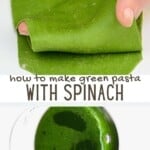











So easy , nice and look delicious. Need to try that. Thanks for sharing dear.
Thank you for your comment, Maïba. I hope you give it a try 🙂